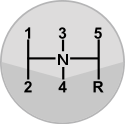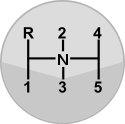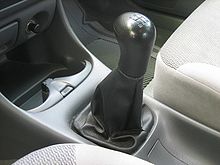- Gear stick
-
A gear stick (also known as gearstick, gear lever, selection lever, shift stick and gear shifter) is the lever used to change gear in a vehicle, such as an automobile, with manual transmission or several common forms of automatic transmission.The device is used to change gear; in a manual transmission vehicle this will normally be done whilst depressing the clutch pedal with the left foot to disengage the engine from the drivetrain and wheels. Automatic transmission vehicles, robotised manuals, and those with continuously variable transmission gearboxes, do not require a clutch pedal.
Contents
Alternative positions
Column shifter in a Ford Crown Victoria.
Gear sticks are most commonly found between the front seats of the vehicle, either on the center console (sometimes even quite far up on the dashboard), the transmission tunnel, or directly on the floor. Some vehicles have a column shift where the lever is mounted on the steering column—this arrangement was once almost standard practice in the United States until relatively recently, which had the added benefit of allowing for a full width bench-type front seat (though some models with bucket seating as an option include it). It has since fallen out of favor, although it can still be found widely on US-market pick-up trucks, vans, and "full-size" US sedans such as the Ford Crown Victoria. A dashboard mounted shift was common on certain French models such as the Citroen 2CV and Renault 4. The Bentley Mark VI had its gear lever to the right of the right-hand drive driver's seat, alongside the driver's door, where it was not unknown for British cars to also have their handbrake. (Left-hand drive models received a column shift.)
In some modern sports cars, the gear lever has been replaced entirely by "paddles", which are a pair of levers, usually operating electrical switches (rather than a mechanical connection to the gearbox), mounted on either side of the steering column, where one increments the gears up, and the other down. Formula 1 cars typically used to hide the gear stick behind the steering wheel within the nose bodywork before the modern practice of mounting the "paddles" on the (removable) steering wheel itself.
The gear knob and switches
The gear knob or shift knob or gear shift knob or stick shift knob is at the end of the gear stick; it forms the handle of the gear stick. Typically the gear knob includes a diagram of the shift pattern of the gear selection system; i.e. the positions to which the gear stick should be moved when selecting a gear. In some older manual transmission vehicles it may incorporate a switch to engage an overdrive; in some automatic transmission vehicles it may incorporate a switch to engage a special mode such as a sports mode. Both of the above-mentioned switches may also be found on the console or on steering column stalks instead. Manual shifters on the steering column, if having only three forward speeds, are typically called a "three on the tree." The lowest of these gears, if set at a much lower ratio than standard 1st-gear ratio, is often called a "granny gear."
Many automatic transmission vehicles have extra controls on the gear stick, or very close by, which modify the choices made by the transmission system depending on engine and road speed; for example, "sports" or "economy" modes which will broadly speaking allow, respectively, for higher and lower revolutions per gear, before changing up.
Some specialist vehicles have controls for other functions on the gear stick. The Land Rover Freelander introduced a button for that company's Hill Descent Control system feature, which uses the brakes to simulate the function of a low-ratio gearbox in steep descents.
Secondary gear levers
In some traditional four-wheel drive "off-road" vehicles there can be a second gear lever which engages a low-ratio gearbox, used on tough terrain. Further, similar-looking levers may switch between two- and four-wheel drive, or engage differential locks; these are not "gear levers," however.
Shift pattern
The shift pattern refers to the layout of the gears. In a typical manual transmission car, first gear is located to the left, and forwards. In many trucks and some sports cars it is instead in a "dog leg" position, to the left and rearwards. There is usually a spring-loading to return the stick to the central position. Reverse gear is commonly positioned in the best choice of location to avoid accidental engagement.
Manual Transmission
A typical manual transmission vehicle, with (for example) five forward gears, will thus have seven possible positions: the five forwards gears, reverse gear, and a central "neutral" position. Some vehicles have a special button to prevent accidental engagement of reverse. Others require that the lever be lifted, pressed down, or moved with extra force to engage reverse. In transmissions with reverse directly below fifth, there may be a mechanical lock-out preventing selection of reverse other than from neutral, thus preventing a driver used to a six-speed transmission from engaging reverse while trying to select sixth.
Common manual transmission shift patterns Layout Description 
This shift pattern is the most common five-speed shift pattern. This layout is reasonably intuitive because it starts at the upper left and works left to right, top to bottom, with reverse at the end of the sequence and toward the rear of the car. 
This shift pattern is another five-speed shift pattern which can be found in Saabs, BMWs, some Audis, Eagle, Volvos, Volkswagens, Škodas, Opels, Hyundais, most Renaults, some diesel Fords, and more.

This shift pattern, sometimes called a Dog leg shift pattern is used on many race cars and on older road vehicles with three-speed transmissions. The name derives from the up-and-over path between first and second gears. Its use is common in race cars and sports cars, but is diminishing as six speed and sequential gearboxes are becoming more common. Having first gear across the dog leg is beneficial as first gear is traditionally only used for getting the car moving and hence it allows second and third gears to be aligned fore and aft of each other, which facilitates shifting between the two. As most racing gearboxes are non-synchromesh there is no appreciable delay when upshifting from first through the dog leg into second. This gear pattern can also be found on some heavy vehicles in which first gear is an extra-low ratio for use in extreme standing-start conditions, and would see little use in normal driving.

This shift pattern is a typical pattern for a six-speed transmission. Six speeds is the maximum usually seen in single range transmissions, however many semi trucks and other large commercial vehicles have manual transmissions with 8, 16 or even 20 speeds, which is made possible due to multi-range gearboxes. In such a case, Reverse is placed outside of the "H," with a canted shift path, to prevent the shift lever from intruding too far into the driver's space (in left-hand drive cars) when reverse is selected. Automatic Transmission
Automatic transmissions traditionally have had a straight pattern beginning at the most forward position with "park" (which locks up the transmission), and running through reverse, neutral, drive (all gears available), and then the lower gears (often three or two more positions, each locking out a successive upper gear), with the rear-most position allowing first gear only. More modern automatic transmissions have employed a "J-gate" (pioneered by Jaguar) where some gears are on the left-hand "arm", some on the right, and there is a sideways movement at the rear of the pattern.
Some modern gearboxes such as the Alfa Romeo Sportronic have a traditional automatic shift pattern to the right, with a special position to the left in which movement of the stick forwards and backwards increments the gears up and down respectively. This can be useful in snow or dirt conditions, where it may be necessary to start from second gear.
Categories:- Vehicle parts
- Automotive transmission technologies
- Automotive accessories
- Vehicle modification
- Automotive industry
Wikimedia Foundation. 2010.



